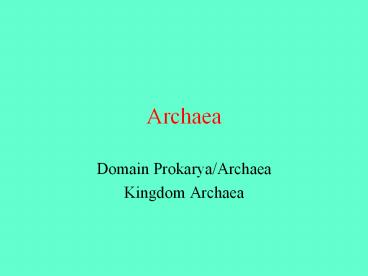Archaea - PowerPoint PPT Presentation
Title: Archaea
1
Archaea
- Domain Prokarya/Archaea
- Kingdom Archaea
2
Discovery of Archaea
- Prior to 1977 they were considered bacteria
- 1977 Carl Woese and George Fox proposed a new
domain/kingdom - 1990 16S rRNA and 18S rRNA sequences justify
separation - 2003 genome sequence analysis justifies
kingdom/domain status
3
Shifting Kingdoms
Lumpers
Splitters
2 3 5 6 8
Bacteria Bacteria Bacteria Bacteria Bacteria
Archaebacteria Archaebacteria Archaebacteria Archaebacteria Archaebacteria
Archezoans Archezoans Archezoans Archezoans Archezoans
Euglenoids Euglenoids Euglenoids Euglenoids Euglenoids
Chrysophytes Chrysophytes Chrysophytes Chrysophytes Chrysophytes
Green Algae Green Algae Green Algae Green Algae Green Algae
Brown Algae Brown Algae Brown Algae Brown Algae Brown Algae
Red algae Red algae Red algae Red algae Red algae
Slime Molds Slime Molds Slime Molds Slime Molds Slime Molds
True Fungi True Fungi True Fungi True Fungi True Fungi
Bryophytes Bryophytes Bryophytes Bryophytes Bryophytes
Tracheophytes Tracheophytes Tracheophytes Tracheophytes Tracheophytes
Protozoans Protozoans Protozoans Protozoans Protozoans
Myxozoans Myxozoans Myxozoans Myxozoans Myxozoans
Multicellular Animals Multicellular Animals Multicellular Animals Multicellular Animals Multicellular Animals
4
How Many Kingdoms?
Extant
Extinct
Long Time with Prokaryotes only
The prokaryotes are a?
Grade!
Original Cell
5
Archaea
- Ancient origin, but appreciated more recently
- Somewhat more advanced than Bacteria
- Extremophiles-90C pH2 25M anaerobic -4C
Antarctica! - Methanogens
- Halophytes
- Sulfur metabolism
- DNA binding proteins (but not histones)
- Unicellular, colonial, filamentous
- Bacillus, coccus, spirillum, plate-like, etc.
- Size 0.1 to 15 µm diam. x 200 µm long
6
Archaea Cladogram
Extant Genera
Thermofilum
Methanobacterium
Halococcus
Sulfolobus
Pyrococcus
Methanococcus
Haloferox
Ferroglobus
Archaeoglobus
Desulfurococcus
Haloarcula
Thermococcus
Pyrobaculum
Thermoproteus
Thermoplasma
Pleurophillus
Pyrodictium
Thermo- coccales
Igneococcales
Thermoproteales
Thermoplasmales
Halobacteriales
Sulfolo- hales
Archaeoglobales
Methanogenales
Sorg-gtH2SCO2
Hydrothermal vents MethanogenR
lactate-gtH2CO2 Autotroph H2SO4-2-gtH2S
Halophilic Chemoheterotroph resp
O2 Chemoautotroph Light-gtbacteriorhodopsin-gtATP Me
thanogens-anaerobes CO2H2-gtF420 fluorescent
-gtCH4 Ruminant gut flora Marshes, landfills
Crenarchaeota
Euarchaeota
Thermophilic Acidophilic Autotrophic (CO2) Sulfur
H2 -gt H2S H -O2 Heterotrophic
(CH2O) SulfurCH2O-gtCO2H2S O2 Heterotrophic
(TCAR) Sulfur O2 -gt H2SO4
to Eukarya
to Bacteria
Original Cell
7
Prokaryotic Growth
- Cells are generally very small
- Cells may double in size but only before binary
fission - Growth mostly in terms of cell number or colony
size, etc. - Doubling time in cell numbers may be 20 minutes
in ideal conditions - Could quickly take over the earth if conditions
could remain ideal - Very competitive in ideal environments
- Ultimate survivors - 3.5 billion years!
8
Cell Structure Boundary
Thermoplasma
cell membrane bilayer phosphoglycerohydrocarbon
, etc. sulfo- or glyco-glycerohydrocarbon
(ether link not ester link) transport proteins
cytosol
regulates input/output
Gram Positive Methanobacterium
Gram Negative Thermoproteus
cell wall-glycan (no muramic acid)
prevents bursting turgor pressure
thin surface layer glycoprotein
releases dye
9
Homeostasis - metabolism
Facultative and Obligate Anaerobes and Aerobes
Nutrition Mode Energy Source Carbon Source
Photoautotroph Light CO2
Chemoautotroph Inorganic chem CO2
Photoheterotroph Light Organic chem
Chemoheterotroph Organic chem Organic chem
Chemoautotroph acetyl-CoA or reverse TCA to fix
CO2 Photoautotroph Calvin Cycle (Methanococcus,
Pyrococcus) Chemoheterotroph citric acid cycle,
fermentation Sulfur transporters used
to drive ATP synthesis
10
How do Archaea tolerate the heat?
- Proteins stabilized by more ionic bridges between
amino acid r-groups and more-hydrophobic core
amino acids - Heat shock protein (chaperonins) refold denatured
proteinsPyrococcus 121C for 1 hour! - DNA depurination reduced by presence of
2,3-diphosphoglycerate. - DNA supercoiling by reverse gyrase reduces
denaturation - Sac7d in Sulfobolus is a minor groove protein
increases the melting temperature by 40C - Histone-like proteins help stabilize DNA as well
- Heat-resistant di-bi-phytanyl diether lipid
membranes (monolayer) prevent delamination of
membrane
11
Cell Membrane Structure
Composed of diglycerides R group may be
phosphate, sulfate, or sugar Long chain branched
hydrocarbon (not fatty acid) Hydrocarbons may be
C20 or C40 If C20, the membrane is a bilayer
If C40, the membrane is a monolayer
In some species, the membrane is a mixture of
both C20 and C40 diglycerides forming a mixed
mono-/bi-layer






























